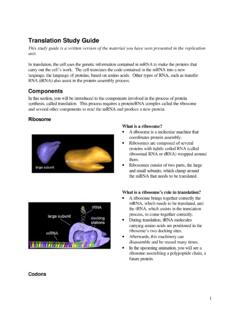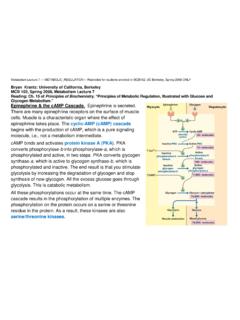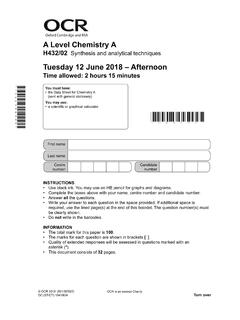Transcription of Cell Communication - Yale University
1 Cell CommunicationPeter TakizawaDepartment of Cell Biology1. Enormously Focus on the Don t try to remember name of every Have taken out names in most figures, where names are listed, probably important. General principles of signaling Why is signaling so complicated? Signaling through steroids and ion channels Cellular signal processingCells communicate to elicit responses and coordinate , Saturday night?Nah, gotta studythe TCA and interpretationResponseCells communicate to change in behavior in one cell and coordinate activities. The language of cells consists of small molecules Receptors in cells detect small molecules and connections between receptors and cellular machinery interpret the signals.
2 cells respond to small molecules by activating certain biochemical molecular language of cells consist of a variety of small and peptidesAmino acids and derivativesGasesSmall hydrophobic moleculesA large number of different molecules function as signaling molecules, and they differ in size and chemical composition. Some are hydrophilic and can t cross the cell membrane. For example, some peptides and proteins function as signaling molecules and neither of these can diffuse across the cell membrane. Other signaling molecules are hydrophobic and can readily diffuse across the cell membrane.
3 These include gases, oxygen and carbon dioxide, and same signaling molecule can evoke different muscle: contractionCardiac muscle: decreased contractionLike our language where the same word can have many different meanings, the same small molecule can have different effects on different cells . For example, acetylcholine is a neurotransmitter that stimulates contraction in skeletal muscle, but in cardiac muscle cells acetylcholine decreases the rate of contraction. The difference between skeletal and cardiac muscle cells is in how they are wired biochemically to respond to : constrict blood vesselsOne molecule can elicit multiple cellular changes to produce an integrated : increase contractionLiver: activate glycolysisMuscle: dilate blood vesselsLiver: activate glycolysisOne signaling molecule can elicit different responses depending on tissue or organ to produces an integrated response.
4 For example, epinephrine affects cells in a variety of organs and tissues to produce a flight or fight response in an organism. cells respond differently to epinephrine depending on which organ or tissue they reside. The biochemical wiring in these cells differs to produce to responses to generate fast and transient or slow and long-term responses to signaling protein functionAlter protein synthesisAlter cytoplasmic machineryAlter cell behaviorCell responses to signaling events can take different lengths of times. A fast response is achieved by altering the activities of existing proteins that lead to changes in cell shape or metabolism.
5 The response is fast because the signaling event acts directly on machinery that controls shape or metabolism. Fast responses are usually reversible as once the signaling molecule is removed the activities of the cell s proteins returns to also respond to signaling molecules by altering gene expression to produce more or less of certain proteins. This is slow response because it requires time to build up or remove protein to cause a change in cell behavior. The slow response often generates long-term changes in cells such as differentiation into a specific type of signaling molecules elicit both types of pathways in versus long distance signalingCommunication between cells can be classified based on the distance over which the Communication takes signaling involves Communication between neighboring paracrine signaling, the signal released by one cell affects cells only in the surrounding area.
6 Importantly, the signaling molecule does not enter blood stream. The connective tissue surrounding the cells restricts the diffusion of the signaling molecule. A special type of paracrine signaling is autocrine in which the cell that produces the signaling molecule also responds to that signaling molecule. Paracrine signaling is important during development as it allows organisms to produce cells that will develop different functions. A signaling molecule (morphogen) released from one point will diffuse away from that point creating a gradient of morphogen concentration.
7 cells will respond differently depending on the concentration of the signaling involves Communication between neighboring paracrine signaling, the signal released by one cell affects cells only in the surrounding area. Importantly, the signaling molecule does not enter blood stream. The connective tissue surrounding the cells restricts the diffusion of the signaling molecule. A special type of paracrine signaling is autocrine in which the cell that produces the signaling molecule also responds to that signaling molecule. Paracrine signaling is important during development as it allows organisms to produce cells that will develop different functions.
8 A signaling molecule (morphogen) released from one point will diffuse away from that point creating a gradient of morphogen concentration. cells will respond differently depending on the concentration of the signaling involves Communication between distal signaling involves cells located at different parts of an organism. Signaling molecules secreted by one cell enter blood stream and travel through blood stream to other parts of body. cells throughout the body have an opportunity to detect and respond to the signaling molecule. Signaling molecules in endocrine signaling are called contact signaling: next door or over the hills and far awayA third type of signaling involves direct interaction between cells .
9 Proteins in the cell membranes of different cells can bind each other and the interaction between these proteins can alter cell behavior. For example, a T-cell uses its receptor to recognize antigen on the surface of antigen presenting cell. Another form of this type of signaling is the Communication between neurons and their target cells . Neurons make contact with their target cell and but don t communicate via these contacts. Instead, they release neurotransmitter at these contact points to affect their target and cell-contact signaling require ligand-receptor binding of different affinity interactionLow affinity interactionThe different types of signaling differ in the strength of interaction between the signaling molecule and the receptor for that molecule.
10 In endocrine signaling, the hormones are present at low concentration because there are distributed throughout the body. In addition, cells are often bathed in a variety of different hormones and other signaling molecules. Thus, the receptors on cells have to distinguish between several different molecules at low concentration. This requires a high affinity interaction between the receptor and its paracrine signaling or signaling via neurons, the signaling molecule is usually present at higher concentration and is sometimes the only signaling molecule present (neurotransmission).








